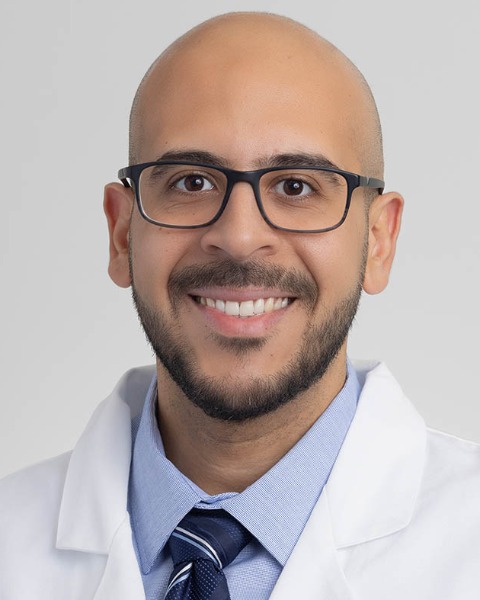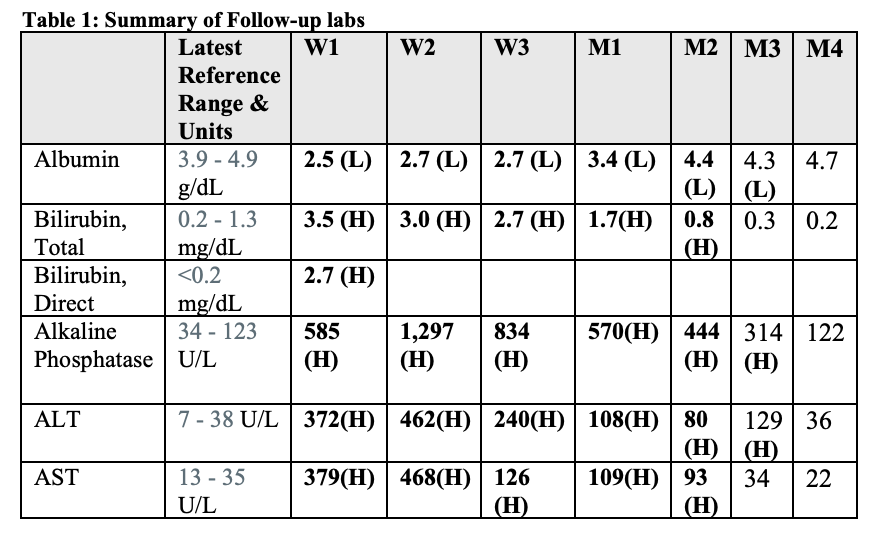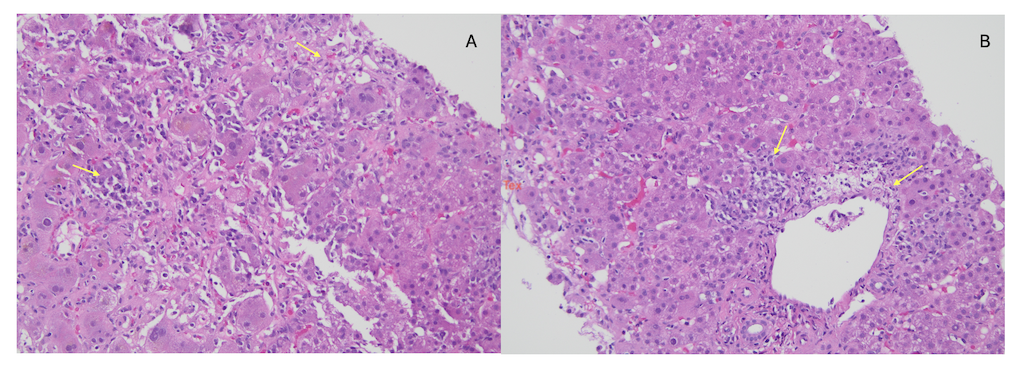Tuesday Poster Session
Category: Liver
P6032 - A Rare Presentation of Adult-Onset Still’s Disease Overlapping Autoimmune Hepatitis
Tuesday, October 28, 2025
10:30 AM - 4:00 PM PDT
Location: Exhibit Hall

Islam B Mohamed, MD (he/him/his)
Cleveland Clinic Foundation
Cleveland, OH
Presenting Author(s)
Islam Mohamed, MD1, Saleh Alghsoon, MD1, Sarah S. Elsoukkary, MD1, Christina C. Lindenmeyer, MD2
1Cleveland Clinic Foundation, Cleveland, OH; 2Cleveland Clinic, Cleveland, OH
Introduction: Adult-onset Still’s disease (AOSD) is a rare systemic inflammatory disorder with hepatic involvement in 60–80% of cases. Liver injury is driven by cytokines (notably IL-18), macrophage/T-cell infiltration, and innate immune dysregulation. This contrasts with autoimmune hepatitis (AIH), which is characterized by T cell-mediated autoimmunity and adaptive immune dysfunction.
Case Description/
Methods: A 31-year-old Hispanic otherwise healthy female presented in week 31 of pregnancy with flu-like symptoms and a generalized rash. Laboratory evaluation revealed a mixed pattern liver injury with an R-factor of 4.16, T bilirubin 8.6 mg/dL, and ALP 829 U/L. INR trended from 1.3 to 1.5. She was transferred to a quaternary center for multidisciplinary management after a spontaneous preterm delivery. Liver work up was negative for acute or chronic viral hepatitis. Notable labs included an ANA of 1:80, IgG 2755 mg/dL, and weakly positive CMV 372 copies/ml. On postpartum transfer liver transaminases trend was; AST/ALT from 379/372 U/L to 351/341U/L; ALP from 585U/L to 608 U/L; T. bilirubin from 3.5 mg/dL to 3.7 mg/dL, but few days later she developed recurrent pruritus and fever. Liver chemistries worsened ALT/AST 462/468 U/L; ALP 1297 U/L. Table A liver biopsy demonstrated lobular inflammation with lymphocytes, histiocytes, plasma cells, neutrophils, and eosinophils, consistent with AIH. Figure Prednisone and Ganciclovir were initiated with rising CMV PCR titers up to 1000 U/L. After transaminase improvement, she was discharged on a steroid taper, azathioprine and valganciclovir. Over the next several weeks, fevers, sporadic polyarthritis and posterior cervical lymphadenopathy recurred. At that time, liver chemistries were near normal, but inflammatory markers were elevated: ferritin 7,000 ng/mL and CRP 5.6 mg/dL. Rheumatology consultation and she was diagnosed with ASOD by Yamaguchi criteria. Anakinra (IL-1 receptor antagonist) was started with significant improvement.
Discussion: Adult-onset Still’s disease (AOSD) is diagnosed clinically by Yamaguchi criteria with no specific immunological markers. It is a cytokine-driven inflammatory condition, while AIH involves adaptive immunity with autoantibodies and plasma cell-rich histology. This case illustrates a rare overlap between AOSD and AIH, underscoring the complexity of diagnosing and managing atypical hepatic manifestations.A multidisciplinary approach is crucial to address this diagnostic and therapeutic challenge.

Figure: Table 1: Summary of Follow-up labs

Figure: Image A legend
The biopsy showed hepatic parenchyma with scattered foci of lobular inflammation comprised predominantly of lymphocytes yellow arrow, histiocytes, and plasma cells, and scattered neutrophils, and eosinophils. Associated hepatocellular injury and lobular disarray, as well as focal multinucleated hepatocytes are seen. Focal centrizonal hepatocellular necrosisyellow arrow is also identified. There is patchy sinusoidal dilatation and associated congestion.
Image B legend
The portal tracts show involvement by a mild to moderate inflammatory infiltrate that is lymphocyte predominant yellow arrow, with scattered plasma cells and rare neutrophils. Associated interface activity and endotheliitis yellow arrow is seen. Mild bile duct injury is also identified. There is no evidence of ductopenia.
Disclosures:
Islam Mohamed indicated no relevant financial relationships.
Saleh Alghsoon indicated no relevant financial relationships.
Sarah Elsoukkary indicated no relevant financial relationships.
Christina Lindenmeyer indicated no relevant financial relationships.
Islam Mohamed, MD1, Saleh Alghsoon, MD1, Sarah S. Elsoukkary, MD1, Christina C. Lindenmeyer, MD2. P6032 - A Rare Presentation of Adult-Onset Still’s Disease Overlapping Autoimmune Hepatitis, ACG 2025 Annual Scientific Meeting Abstracts. Phoenix, AZ: American College of Gastroenterology.
1Cleveland Clinic Foundation, Cleveland, OH; 2Cleveland Clinic, Cleveland, OH
Introduction: Adult-onset Still’s disease (AOSD) is a rare systemic inflammatory disorder with hepatic involvement in 60–80% of cases. Liver injury is driven by cytokines (notably IL-18), macrophage/T-cell infiltration, and innate immune dysregulation. This contrasts with autoimmune hepatitis (AIH), which is characterized by T cell-mediated autoimmunity and adaptive immune dysfunction.
Case Description/
Methods: A 31-year-old Hispanic otherwise healthy female presented in week 31 of pregnancy with flu-like symptoms and a generalized rash. Laboratory evaluation revealed a mixed pattern liver injury with an R-factor of 4.16, T bilirubin 8.6 mg/dL, and ALP 829 U/L. INR trended from 1.3 to 1.5. She was transferred to a quaternary center for multidisciplinary management after a spontaneous preterm delivery. Liver work up was negative for acute or chronic viral hepatitis. Notable labs included an ANA of 1:80, IgG 2755 mg/dL, and weakly positive CMV 372 copies/ml. On postpartum transfer liver transaminases trend was; AST/ALT from 379/372 U/L to 351/341U/L; ALP from 585U/L to 608 U/L; T. bilirubin from 3.5 mg/dL to 3.7 mg/dL, but few days later she developed recurrent pruritus and fever. Liver chemistries worsened ALT/AST 462/468 U/L; ALP 1297 U/L. Table A liver biopsy demonstrated lobular inflammation with lymphocytes, histiocytes, plasma cells, neutrophils, and eosinophils, consistent with AIH. Figure Prednisone and Ganciclovir were initiated with rising CMV PCR titers up to 1000 U/L. After transaminase improvement, she was discharged on a steroid taper, azathioprine and valganciclovir. Over the next several weeks, fevers, sporadic polyarthritis and posterior cervical lymphadenopathy recurred. At that time, liver chemistries were near normal, but inflammatory markers were elevated: ferritin 7,000 ng/mL and CRP 5.6 mg/dL. Rheumatology consultation and she was diagnosed with ASOD by Yamaguchi criteria. Anakinra (IL-1 receptor antagonist) was started with significant improvement.
Discussion: Adult-onset Still’s disease (AOSD) is diagnosed clinically by Yamaguchi criteria with no specific immunological markers. It is a cytokine-driven inflammatory condition, while AIH involves adaptive immunity with autoantibodies and plasma cell-rich histology. This case illustrates a rare overlap between AOSD and AIH, underscoring the complexity of diagnosing and managing atypical hepatic manifestations.A multidisciplinary approach is crucial to address this diagnostic and therapeutic challenge.

Figure: Table 1: Summary of Follow-up labs

Figure: Image A legend
The biopsy showed hepatic parenchyma with scattered foci of lobular inflammation comprised predominantly of lymphocytes yellow arrow, histiocytes, and plasma cells, and scattered neutrophils, and eosinophils. Associated hepatocellular injury and lobular disarray, as well as focal multinucleated hepatocytes are seen. Focal centrizonal hepatocellular necrosisyellow arrow is also identified. There is patchy sinusoidal dilatation and associated congestion.
Image B legend
The portal tracts show involvement by a mild to moderate inflammatory infiltrate that is lymphocyte predominant yellow arrow, with scattered plasma cells and rare neutrophils. Associated interface activity and endotheliitis yellow arrow is seen. Mild bile duct injury is also identified. There is no evidence of ductopenia.
Disclosures:
Islam Mohamed indicated no relevant financial relationships.
Saleh Alghsoon indicated no relevant financial relationships.
Sarah Elsoukkary indicated no relevant financial relationships.
Christina Lindenmeyer indicated no relevant financial relationships.
Islam Mohamed, MD1, Saleh Alghsoon, MD1, Sarah S. Elsoukkary, MD1, Christina C. Lindenmeyer, MD2. P6032 - A Rare Presentation of Adult-Onset Still’s Disease Overlapping Autoimmune Hepatitis, ACG 2025 Annual Scientific Meeting Abstracts. Phoenix, AZ: American College of Gastroenterology.
